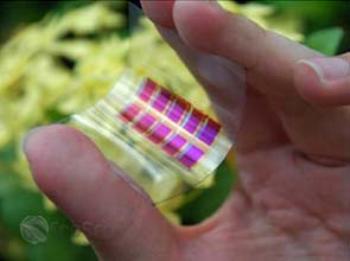A new polymer has been developed by A*STAR’s Institute of Materials Research and Engineering (IMRE), which opens up innovative design options for the organic solar cell and electronic companies.
 Flexible, organic solar cells
Flexible, organic solar cells
The polymer offers higher solar power conversion efficiency and charge mobility that could lead to cheaper plastic solar cells and electronics.
IMRE’s polymer produces the same charge mobility value (0.2 cm2/V.s) that is generated by commercially available semiconducting materials. The material also has a solar power conversion efficiency of 6.3%.
Existing polymers normally show their excellence in one aspect, that is they will either be a good conductor for electronic applications or will possess high power conversion efficiency. But, the new polymer material has both these features.
The polymer is used to produce various electronic components, as well as it can be utilized to transform sunlight into electricity. The application of the material is carried out by rolling the polymer into a film, thus enabling production of printed solar cells and electronics in a large scale.
IMRE’s new polymer helps electronics and solar cells manufactures to save costs and it can be used to design new devices requiring electronics and energy harvesting as a single unit. The institute’s research data has been released in the “Advanced Materials” journal.